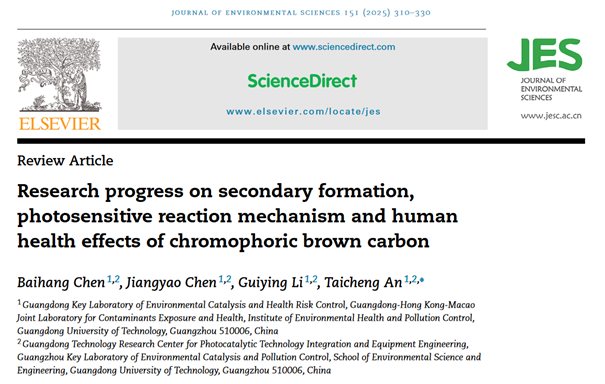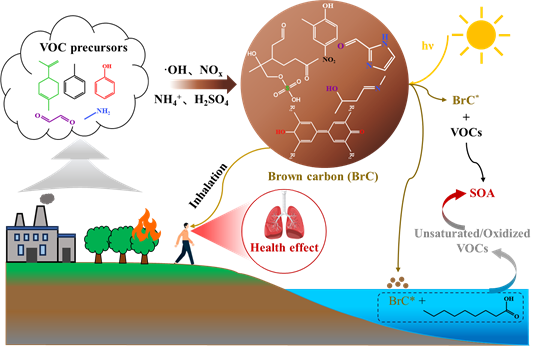近日,广东工业大学环境健康与污染控制研究院、环境科学与工程学院安太成教授团队在大气棕色碳方面取得最新综述性研究进展,研究成果以《Research progress on secondary formation, photosensitive reaction mechanism and human health effects of chromophoric brown carbon》为题发表在Journal of Environmental Sciences(2025, 151, 310-330; https://doi.org/10.1016/j.jes.2024.04.003)期刊上。论文的第一作者为硕士生陈柏杭,通讯作者为安太成教授。由于棕色碳最初是物理学上定义的一类物质,目前研究逐渐转向对其化学官能团的鉴定,并且棕色碳的吸光能力、化学性质和健康效应主要取决于其发色团的化学组成。因此在这项综述论文中,作者主要对目前文献中已经鉴定出来的棕色碳发色团从化学结构上进行分类,并在此基础上对棕色碳发色团的二次形成机制、光敏反应以及对人体健康的影响等方面进行综述。首先将棕色碳发色团分为五类:含氮杂环物种、含氮链状物种、芳香族物种(包括硝基芳香烃、含氧芳香烃、多环芳烃及其衍生物等)、低聚物(包括单羰基和二羰基低聚物、酚类物质低聚物等)和含硫有机化合物。不同的发色团前体种类表现出差异,其形成机制也各不相同。含氮杂环和含氮链状物种主要由羰基化合物和还原性氮物种形成,芳香族物种由芳香烃光氧化形成,低聚物则由其对应的单体低聚化形成。其次由于棕色碳是生物质和化石燃料不完全燃烧过程中形成的吸光颗粒的重要成分,可能是大气中一类潜在的光敏剂,可以引发二次有机气溶胶(SOA)前体的产生或者导致SOA的增长,在液相SOA的形成中起到重要作用,对人体健康也可能会产生不利的影响。最后通过发展进一步完全分离的棕色碳实验方法以及完善算法和机器学习能力等可以更有效地认识棕色碳发色团的化学组成,在此基础上进一步研究各类发色团及其形成过程中的光敏性和毒性,以更好地评估棕色碳的大气效应和健康效应。综上所述,本文基于化学结构综述了BrC发色团的分类、二次形成机制、光敏反应以及对人体健康的影响等方面的最新进展。

论文网址:https://doi.org/10.1016/j.jes.2024.04.003
棕色碳(BrC)对紫外-可见波长范围内的太阳辐射有较强的吸收能力,对人体健康造成不良影响,引起了人们的广泛关注。最初,BrC是物理上定义的一类物质。然而,目前的研究逐渐转向其化学官能团的鉴定,因为其吸光能力、化学性质和健康效应主要取决于其发色团的化学组成。因此,本文主要从对BrC发色团的化学认识出发,对BrC发色团的二次形成机制、光敏反应以及BrC对人体健康的影响等方面进行综述。首先,将BrC发色团分为五类:含氮杂环物种、含氮链状物种、芳香族物种、低聚物和含硫有机化合物。不同的发色团前体种类表现出差异,其形成机制也各不相同。其次,由于BrC是生物质和化石燃料不完全燃烧过程中形成的吸光颗粒的重要成分,BrC可以触发二次有机气溶胶(SOA)前体的产生或导致SOA的增长,可能对人体健康产生不利影响。最后,为BrC开发充分分离的方法并改进算法和机器学习,可以更有效地了解发色团的化学组成,从而更好地评估BrC的大气效应和健康影响。综上所述,本文基于化学结构综述了BrC发色团的分类、二次形成机制、光敏反应以及对人体健康的影响等方面的新进展。
图片摘要:

英文摘要:
Brown carbon (BrC) has attracted widespread attention because of its strong absorption of solar radiation in the ultraviolet-visible wavelength range, which causes adverse impacts on human health. Originally, BrC was a physically defined class of substances. However, current research has gradually shifted towards the identification of its chemical groups, because its light-absorbing capability, chemical properties and health effects mainly depend on the chemical composition of its chromophores. Therefore, this review mainly focuses on the chemical understanding of BrC based on chromophores, and the secondary formation mechanism of chromophores, photosensitized reactions, and human health effects of BrC were detailly summarized. Firstly, BrC chromophores are divided into five categories: nitrogen-heterocycles, nitrogen-chain, aromatic species, oligomers and sulfur-containing organic compounds. Different chromophore precursor species exhibit variations, and their formation mechanisms are also distinct. Secondly, BrC can trigger the production of secondary organic aerosol (SOA) precursors or cause SOA growth because BrC is an important component of light-absorbing particles formed during incomplete combustion of biomass and fossil fuels, potentially exerting adverse effects on human health. Finally, developing sufficiently separated methods for BrC and refining algorithms and machine learning can lead to a more effective understanding of the chemical composition of chromophores, thus enabling better evaluation of the atmospheric effects and health impacts of BrC. In all, this review provides new insights into the categories of BrC chromophores and new advance in secondary formation mechanisms, photosensitized reactions, and human health effects on the basis of chemical structures.
资助项目:本研究得到国家自然科学基金(42020104001,42177354)、国家重大科研仪器研制项目(42327806)的支持